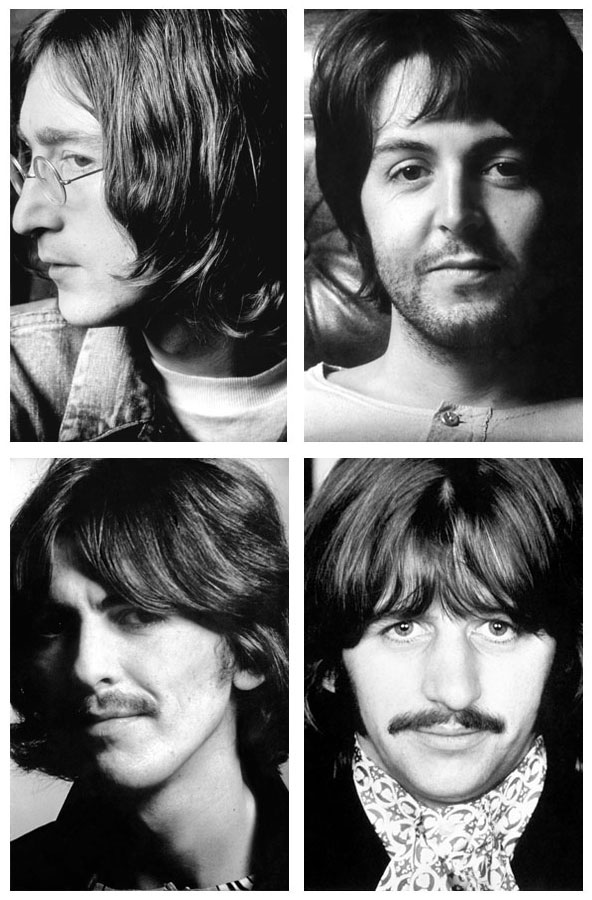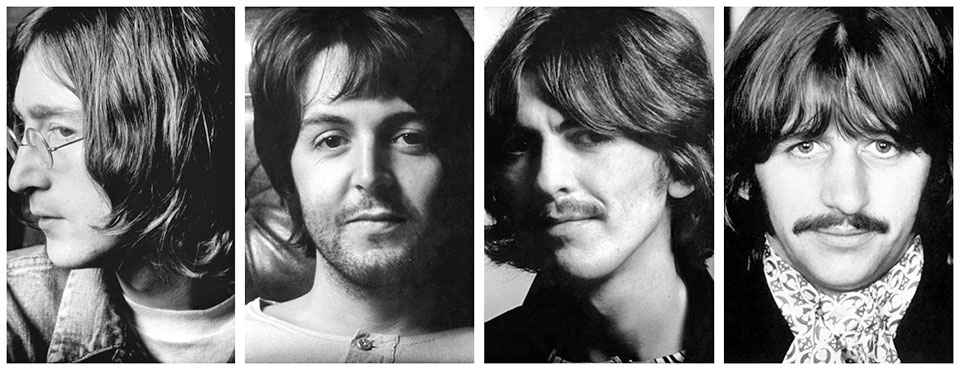The White Album Listening Party: Revisiting The Beatles’ Top-Seller
Beatle fans and musicians gather to re-experience the top-selling album, which came to be known as The White Album
Air Date: 23 November 2008
Host: Paul Ingles | PRX
Broadcast: KUFM | Montana Public Radio
Time: 02:57:03
Award-winning producer Paul Ingles takes another one of his in-depth explorations of The Beatles’ experience. Ingles recalls being 12 years old in 1968 and listening with his best friend to this challenging and, at times, disturbing collection in the basement of his suburban Maryland home. “I knew I couldn’t play this one on the family stereo upstairs,” says Ingles. “A lot of the music seemed naughty, tortured and edgy.” In an effort to re-create that listening experience, Ingles invited about a dozen Beatle fans into the studio to listen through to the album again and share both their memories and more current observations about the landmark music.
Emerging from what many called their three-album psychedelic period that produced Sgt. Pepper, Magical Mystery Tour and Yellow Submarine, The Beatles’ White Album was a wildly diverse collection that included instant classics Back in the U.S.S.R, While My Guitar Gently Weeps, Dear Prudence, Blackbird, gentle ballads Mother Nature’s Son, I Will, Julia, raucous electric rock Helter Skelter, Yer Blues amusing ditties Honey Pie, Savoy Truffle, Rocky Raccoon, and surprising experimental tracks Revolution #9. The writing and performing styles of the four individual Beatles became distinct. Many Beatle fans and historians point to the White Album as the beginning of the break-up of the Beatles. In little over a year, the band would be dissolved.
I knew I couldn’t play this one on the family stereo upstairs… a lot of the music seemed naughty, tortured and edgy.
~ Paul Ingles
Among the guests is Beatle author Steve Turner who shares the stories behind each of the White Album tracks. Also, a panel of musicians helps listeners tune into the musicality of The Beatles, calling attention to a certain bass line here, a drum lick there, a production trick over there. Other friends share stories of dancing to Ob-La-Di-Ob-La-Da, dropping acid to Glass Onion, or being scared to death by Helter Skelter and wishing for a return of the ol’ mop-tops. Hour 3 even includes a special combination of both versions of Revolution, the fast single and the slower White Album version, mixed and mashed together, courtesy of engineer Douglas Grant. In addition to Steve Turner, Paul’s guest list includes musicians Jon Spurney, David Gans, Kristy Kruger, Douglas Grant, and Rob Martinez. KUNM radio personalities Scott MacNicholl, Luciano Urbano, Suzanne Kryder, and Travis Parkin join in as well.
NOTE: November 22, 2008 marked the 40th Anniversary of one of The Beatles’ most remarkable releases. The two-album set was officially called THE BEATLES, but it became known forever after as The White Album. It was the top-selling of all The Beatles’ albums and ranks #11 on the all-time album sales list. Emerging from what many called their three-album psychedelic period that produced Sgt. Pepper, Magical Mystery Tour and Yellow Submarine, The Beatles’ White Album was a wildly diverse collection that included instant classics Back in the U.S.S.R, While My Guitar Gently Weeps, Dear Prudence, Blackbird, gentle ballads Mother Nature’s Son, I Will, Julia, raucous electric rock Helter Skelter, Yer Blues amusing ditties Honey Pie, Savoy Truffle, Rocky Raccoon, and surprising experimental tracks Revolution #9. The writing and performing styles of the four individual Beatles became distinct. Many Beatle fans and historians point to the White Album as the beginning of the break-up of the Beatles. In little over a year, the band would be dissolved.
Air Date: 23 November 2008
Host: Paul Ingles | PRX
Broadcast: KUFM | Montana Public Radio
Time: 02:57:03
Award-winning producer Paul Ingles takes another one of his in-depth explorations of The Beatles’ experience. Ingles recalls being 12 years old in 1968 and listening with his best friend to this challenging and, at times, disturbing collection in the basement of his suburban Maryland home. “I knew I couldn’t play this one on the family stereo upstairs,” says Ingles. “A lot of the music seemed naughty, tortured and edgy.” In an effort to re-create that listening experience, Ingles invited about a dozen Beatle fans into the studio to listen through to the album again and share both their memories and more current observations about the landmark music.
I knew I couldn’t play this one on the family stereo upstairs… a lot of the music seemed naughty, tortured and edgy.
~ Paul Ingles
Emerging from what many called their three-album psychedelic period that produced Sgt. Pepper, Magical Mystery Tour and Yellow Submarine, The Beatles’ White Album was a wildly diverse collection that included instant classics Back in the U.S.S.R, While My Guitar Gently Weeps, Dear Prudence, Blackbird, gentle ballads Mother Nature’s Son, I Will, Julia, raucous electric rock Helter Skelter, Yer Blues amusing ditties Honey Pie, Savoy Truffle, Rocky Raccoon, and surprising experimental tracks Revolution #9. The writing and performing styles of the four individual Beatles became distinct. Many Beatle fans and historians point to the White Album as the beginning of the break-up of the Beatles. In little over a year, the band would be dissolved.
Among the guests is Beatle author Steve Turner who shares the stories behind each of the White Album tracks. Also, a panel of musicians helps listeners tune into the musicality of The Beatles, calling attention to a certain bass line here, a drum lick there, a production trick over there. Other friends share stories of dancing to Ob-La-Di-Ob-La-Da, dropping acid to Glass Onion, or being scared to death by Helter Skelter and wishing for a return of the ol’ mop-tops. Hour 3 even includes a special combination of both versions of Revolution, the fast single and the slower White Album version, mixed and mashed together, courtesy of engineer Douglas Grant. In addition to Steve Turner, Paul’s guest list includes musicians Jon Spurney, David Gans, Kristy Kruger, Douglas Grant, and Rob Martinez. KUNM radio personalities Scott MacNicholl, Luciano Urbano, Suzanne Kryder, and Travis Parkin join in as well.
The Beatles alternative album inserts photos.
NOTE: November 22, 2008 marked the 40th Anniversary of one of The Beatles’ most remarkable releases. The two-album set was officially called THE BEATLES, but it became known forever after as The White Album. It was the top-selling of all The Beatles’ albums and ranks #11 on the all-time album sales list. Emerging from what many called their three-album psychedelic period that produced Sgt. Pepper, Magical Mystery Tour and Yellow Submarine, The Beatles’ White Album was a wildly diverse collection that included instant classics Back in the U.S.S.R, While My Guitar Gently Weeps, Dear Prudence, Blackbird, gentle ballads Mother Nature’s Son, I Will, Julia, raucous electric rock Helter Skelter, Yer Blues amusing ditties Honey Pie, Savoy Truffle, Rocky Raccoon, and surprising experimental tracks Revolution #9. The writing and performing styles of the four individual Beatles became distinct. Many Beatle fans and historians point to the White Album as the beginning of the break-up of the Beatles. In little over a year, the band would be dissolved.







